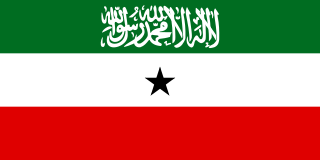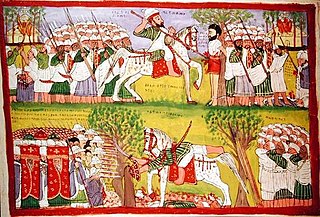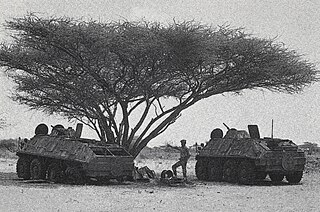This article needs additional citations for verification .(January 2017) |
This is a list of wars involving the Federal Democratic Republic of Ethiopia (modern-day Ethiopia) and its predecessor states.
This article needs additional citations for verification .(January 2017) |
This is a list of wars involving the Federal Democratic Republic of Ethiopia (modern-day Ethiopia) and its predecessor states.
| Conflict | Combatant 1 | Combatant 2 | Results |
|---|---|---|---|
| Conquests of Amda Seyon I (1316–1332) | | Victories
| |
| Reconquests of Sabr Ad Din (1415-1430) | | | Defeat
|
| Badley ad-Din II's Invasion of Ethiopia (1445) | | | Victory |
| Abyssinian–Adal War (1529–1543) | Stalemate | ||
| Iyasu II's Invasion of Sennar (1738) | | Defeat
| |
| Zemene Mesafint (1769–1855) | | | Reunification of Ethiopia
|
| Ottoman–Ethiopian border conflicts (1832–1848) | | Victory
| |
| British Expedition to Abyssinia (1867–1868) | | Defeat
| |
| Ethiopian–Egyptian War (1874–1876) | | | Victory
|
| Mahdist War (1881–1889) | | Victory
| |
| Italo-Ethiopian War of 1887–1889 | | Victory [5]
| |
| Menelik's Expansions (Late 19th century) | Victories
| ||
| First Italo-Ethiopian War (1896) | Victory
| ||
| Dervish War (1900–1920) | Ethiopian allied victory
| ||
| Second Italo-Ethiopian War (1935–1937) | Defeat
| ||
| East African Campaign (1940–1941) | Ethiopian allied victory
| ||
| Woyane rebellion (1943) |
| Tigrayan rebels | Victory
|
| Korean War (1950–1953) | Stalemate | ||
| Congo Crisis (1960–1964) | | Victory
| |
| Bale Revolt (1963–1970) | Victory
| ||
| 1964 Ethiopian–Somali War (1964) | Stalemate |
| Conflict | Combatant 1 | Combatant 2 | Results |
|---|---|---|---|
| Eritrean War of Independence (1961–1991) | and allies | Defeat
| |
| Ethio-Somali War (1977–1978) | and allies | Victory
| |
| 1982 Ethiopian-Somali Border War (1982) | and allies |
| Stalemate
|
| Ethiopian Civil War (1974–1991) | | Regime change |
| Conflict | Combatant 1 | Combatant 2 | Results |
|---|---|---|---|
| Insurgency in Ogaden (1995–2008) | | Victory
| |
| Eritrean–Ethiopian War (1998–2000) | Victory | ||
| Ethiopian occupation of Somalia (2006–2009) | Victory
| ||
| Oromia–Somali clashes (2016–present) | Ongoing | ||
| OLA insurgency (2018–present) | Ongoing | ||
| Benishangul-Gumuz conflict (2019–2022) |
| Ongoing
| |
| Tigray War (2020–2022) |
| Victory
| |
| 2020–21 Ethiopian–Sudanese clashes (2020–present) |
| Ongoing
| |
| War in Amhara (2023–present) | Ongoing |
The conclusion of the war is coded as a compromise

Somalia, officially the Federal Republic of Somalia, is the easternmost country in continental Africa. The country is on the Horn of Africa and is bordered by Ethiopia to the west, Djibouti to the northwest, the Gulf of Aden to the north, the Indian Ocean to the east, and Kenya to the southwest. Somalia has the longest coastline on Africa's mainland. Somalia has an estimated population of around 17.1 million, of which over 2 million live in the capital and largest city Mogadishu. Around 85% of its residents are ethnic [[Somali and bantu people. Majority of somalis are mixed with Bantus, Oromos, Afar and other tribes in the region. The name Somali was given because of the language but ethically they're macrobian by all first and secondly Ogaaden. The official languages of Somalia are Somali and Arabic, though the former is the primary language. The people of Somalia are Muslims, the majority of them Sunni.

Somaliland, officially the Republic of Somaliland, is an unrecognised country in the Horn of Africa, recognised internationally as de jure part of Somalia. It is located in the southern coast of the Gulf of Aden and bordered by Djibouti to the northwest, Ethiopia to the south and west, and Somalia to the east. Its claimed territory has an area of 176,120 square kilometres (68,000 sq mi), with approximately 6.2 million residents as of 2024. The capital and largest city is Hargeisa. The Government of Somaliland regards itself as the successor state to British Somaliland, which, as the briefly independent State of Somaliland, united from 1960 to 1991 with the Trust Territory of Somaliland to form the Somali Republic.

The Horn of Africa (HoA), also known as the Somali Peninsula, is a large peninsula and geopolitical region in East Africa. Located on the easternmost part of the African mainland, it is the fourth largest peninsula in the world. It is composed of Somalia, Djibouti, Ethiopia, and Eritrea. Although not common, broader definitions include parts or all of Kenya and Sudan. It has been described as a region of great geopolitical and strategic importance, since it is situated along the southern boundary of the Red Sea; extending hundreds of kilometres into the Gulf of Aden, Guardafui Channel, and Indian Ocean, it also shares a maritime border with the Arabian Peninsula.

The Somali Region, also known as Soomaali Galbeed and officially the Somali Regional State, is a regional state in eastern Ethiopia. Its territory is the largest after Oromia Region. The regional state borders the Ethiopian regions of Afar and Oromia and the chartered city Dire Dawa to the west, as well as Djibouti to the north, Somalia to the northeast, east and south; and Kenya to the southwest.

Ogaden is one of the historical names used for the modern Somali Region which forms the eastern portion of Ethiopia and borders Somalia. It includes another region in the north known as the Haud.

The Ogaden War, also known as the Ethio-Somali War, was a military conflict fought between Somalia and Ethiopia from July 1977 to March 1978 over the sovereignty of Ogaden. Somalia's invasion of the region, precursor to the wider war, met with the Soviet Union's disapproval, leading the superpower to end its support for Somalia to fully support Ethiopia instead.

The Somali Civil War is an ongoing civil war that is taking place in Somalia. It grew out of resistance to the military junta which was led by Siad Barre during the 1980s. From 1988 to 1990, the Somali Armed Forces began engaging in combat against various armed rebel groups, including the Somali Salvation Democratic Front in the northeast, the Somali National Movement in the northwest, and the United Somali Congress in the south. The clan-based armed opposition groups overthrew the Barre government in 1991.
The Dir is one of the largest and most prominent Somali clans in the Horn of Africa. They are also considered to be the oldest Somali stock to have inhabited the region. Its members inhabit Djibouti, Somalia, Ethiopia, and northeastern Kenya.

The Ethiopian invasion of Somalia, also known as the Ethiopian occupation of Somalia or the Ethiopian intervention in the Somali Civil War, was an armed conflict that lasted from late 2006 to early 2009. It began when military forces from Ethiopia, supported by the United States, invaded Somalia to depose the Islamic Courts Union (ICU) and install the Transitional Federal Government (TFG). The conflict continued after the invasion when an anti-Ethiopian insurgency emerged and rapidly escalated. During 2007 and 2008, the insurgency recaptured the majority of territory lost by the ICU.

The Ethiopian–Somali conflict is a territorial and political dispute between Ethiopia, Somalia, and insurgents in the area.

The Ethiopian–Adal War or Abyssinian–Adal War, also known in Arabic as the "Futuḥ al-Ḥabash", was a military conflict between the Christian Ethiopian Empire and the Muslim Adal Sultanate from 1529 to 1543. The Christian Ethiopian troops consisted of the Amhara, Tigrayans, Tigrinya and Agaw people, and at the closing of the war, supported by a few hundred Portuguese musketmen. Whereas Adal forces were mainly composed of Harla, Somali, Afar, as well as Arab and Turkish gunmen. Both sides at times would see the Maya mercenaries join their ranks.

The 1982 Ethiopian–Somali Border War occurred between June and August 1982 when Ethiopia, sending a 10,000 man invasion force backed by warplanes and armored units, supported by thousands of Somali Salvation Democratic Front (SSDF) rebels invaded central Somalia.

Djibouti, officially the Republic of Djibouti, is a country in the Horn of Africa, bordered by Somalia to the south, Ethiopia to the southwest, Eritrea in the north, and the Red Sea and the Gulf of Aden to the east. The country has an area of 23,200 km2 (8,958 sq mi).

The Harari people are a Semitic-speaking ethnic group which inhabits the Horn of Africa. Members of this ethnic group traditionally reside in the walled city of Harar, simply called Gēy "the City" in Harari, situated in the Harari Region of eastern Ethiopia. They speak the Harari language, a member of the South Ethiopic grouping within the Semitic subfamily of the Afroasiatic languages.
The Harla, also known as Harala, Haralla are an ethnic group that once inhabited Ethiopia, Somalia, and Djibouti. They spoke the now-extinct Harla language, which belonged to either the Cushitic or Semitic branches of the Afroasiatic family.

The Eritrean–Ethiopian border conflict was a violent standoff and a proxy conflict between Eritrea and Ethiopia lasting from 1998 to 2018. It consisted of a series of incidents along the then-disputed border; including the Eritrean–Ethiopian War of 1998–2000 and the subsequent Second Afar insurgency. It included multiple clashes with numerous casualties, including the Battle of Tsorona in 2016. Ethiopia stated in 2018 that it would cede Badme to Eritrea. This led to the Eritrea–Ethiopia summit on 9 July 2018, where an agreement was signed which demarcated the border and agreed a resumption of diplomatic relations.

The Isaaq genocide, also known as the Hargeisa holocaust, was the systematic, state-sponsored genocide of Isaaq civilians between 1987 and 1989 by the Somali Democratic Republic, under the dictatorship of Siad Barre, during the Somaliland War of Independence. The number of civilian deaths in this massacre is estimated to be between 50,000 and 100,000, according to various sources, whilst local reports estimate the total civilian deaths to be upwards of 200,000 Isaaq civilians. The genocide also included the levelling and complete destruction of the second and third largest cities in the Somali Republic, Hargeisa and Burao, respectively, and had caused up to 500,000 Somalis of the region, primarily of the Isaaq clan, to flee their land and cross the border to Hartasheikh in Ethiopia as refugees in what was described as "one of the fastest and largest forced movements of people recorded in Africa", which resulted in the creation of the world's largest refugee camp then (1988), with another 400,000 being displaced. The scale of destruction led to Hargeisa being known as the 'Dresden of Africa'. The killings happened during the Somali Civil War and have been referred to as a "forgotten genocide".

The 1964 Ethiopian–Somali Border War, also known as the First Ogaden War marked the first military conflict between the newly established Somali Republic and the Ethiopian Empire, lasting from February to April 1964. The border conflict was preceded by a rebellion in the Ogaden region mid-1963 that was waged by Somalis seeking self-determination from imperial rule. The subsequent suppression of insurgents and increasingly harsh reprisals carried out by Emperor Haile Selassie's government resulted in a rapid decline in Ethio-Somali relations, eventually leading to direct confrontation between both governments' armed forces.

The Somaliland War of Independence was a rebellion waged by the Somali National Movement (SNM) against the ruling military junta in Somalia led by General Siad Barre lasting from its founding on 6 April 1981 and ended on 18 May 1991 when the SNM declared what was then northern Somalia independent as the Republic of Somaliland. The conflict served as the main theater of the larger Somali Rebellion that started in 1978. The conflict was in response to the harsh policies enacted by the Barre regime against the main clan family in Somaliland, the Isaaq, including a declaration of economic warfare on the clan-family. These harsh policies were put into effect shortly after the conclusion of the disastrous Ogaden War in 1978.